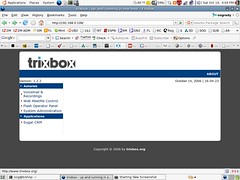After a friend of mine dropped off a used Dell Dimension 4500 that his employer had condemned to the recycling heap this morning, I finally had the dedicated VOIP box I was looking for and set to work getting Trixbox set up on it. Trixbox [1], for those of you who aren’t open source telephony geeks, is a project designed to put a nice face on Asterisk – one of the more important open source projects going, IMO – and make it easier to use. In between running a couple of errands today, I shepherded it through the installation process which failed at first when using the i586 option, failed a second time for an undetermined reason, but third time was the charm and everything finally laid down relatively neatly using the default 386 option.
After the simple, CentOS based installation process, I would not have been successful with even the most basic configuration were it not for Nerd Vittles truly superlative documentation. This was precisely what I needed to take the next step, and its documentation like this that allows the only moderately geeky – such as yours truly – to get things up and running quickly.
The immediate plan is to get this box up and running to cope with my home phone line – currently serviced by Packet8. Unfortunately, according to the Packet8 forums, my current provider does not place nicely with Asterisk. A decision, therefore, needs to be made as to a.) continue w/ Packet8 and secure a hardware device (FXO card) to integrate the VOIP line into my Asterisk infrastructure, or b.) go with a more SIP friendly provider like Axvoice or TelaSIP – both of which come recommended by the Nerd Vittles crew. I’ve got pending questions open in a few forums to help me figure that one out, but if any of you have experience and/or recommendations here they’d be much appreciated.
Once I connect a VOIP provider to my new installation, I’ll be able to route my voicemail to email (though Packet8 does do this now), schedule wakeup calls, get weather reports by phone, set up proximity calling (routing calls automatically based on whether or not my Bluetooth cellphone is detected), and more. There are also automated podcasting solutions, hold music functionality, custom inbound calling rules (which would allow me, in theory, to do away with one line), and so on. Boring, Asterisk is not.
Longer term I’d like to route the RedMonk toll free number (866.RED.MONK) in here, then setup custom forwarding rules to send you to whichever of the three of us you’re looking for. Little ways to go before I get there, however.
In the meantime, let me express my sincere appreciation for the work of the Trixbox team, their forum participants, Mark Spencer and the folk from Digium, the gang over at Nerd Vittles and everyone else who’s chimed in with advice. Will keep you posted on future progress.
[1] Formerly called Asterisk@Home, and recently purchased by Fonality.


SeanKerner says:
October 17, 2006 at 8:45 am
Did you by any chance check out Digium’s Asterisk Business Edition (http://www.digium.com/en/products/software/abe.php)?
From what i’ve been able to test, the rPath base makes it run much much better than waht Trixbox can do with CentOS.